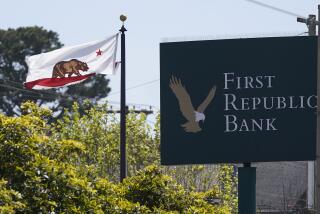Bank Board to Propose Rule for S&Ls; to Increase Capital by 50%
- Share via
WASHINGTON — Federal regulators said Monday that they will propose requiring savings and loan institutions to boost their capital by as much as 50% over four years to bolster their financial position.
Federal Home Loan Bank Board officials said they hoped that the new rules would strengthen thrift institutions and prevent the Federal Savings and Loan Insurance Corp. from becoming insolvent again.
Thrift industry spokesmen said they generally supported the proposal, but the bank board is likely to be urged to lower the proposed capital levels and make other changes before the rule becomes final.
The bank board, which operates FSLIC, proposed that thrifts hold capital averaging 8% of assets as a cushion against unforeseen losses.
That would be an increase from the present rule under which thrifts maintain capital of 3.25% of liabilities on average and eventually must reach 6%.
“We hope this will lead to the provision of more capital to the industry and direct thrifts toward safe and sounder investments,” bank board Chairman M. Danny Wall said after the board agreed it would issue a proposal for comment.
Would Insulate Thrifts
The proposal will encourage saving and loan associations to grow less rapidly, regulators said. Fast growth through risky investments has been blamed for many of the industry’s losses, which reached $7.5 billion in the first half of 1988.
FSLIC, which insures deposit accounts, faces liabilities of $50 billion to $100 billion, far in excess of its assets to rescue insolvent thrifts, many concentrated in the Southwest.
“The philosophy behind this regulation is that thrifts should be insulated with sufficient capital,” bank board member Roger Martin said.
The 3,100 U.S. thrifts maintain $68 billion in capital and would have to provide an additional $16 billion to $33 billion if the rule is adopted, bank board staff said.
The proposal would also tie each thrift’s capital requirement to the risks in its holdings in a way similar to proposed rules for commercial banks.
“We go one step forward from the bank regulation by taking into consideration interest rate risk,” Martin said.
The thrift proposal calls for a minimum 6% of capital against credit risk, such as a default on a loan, and an additional 2% on average for interest rate risk, or losses from a fall in interest rates.
Would Cause Problems
The thrift industry favors risk-based capital requirements because the federal deposit insurance allows thrift managers who take the biggest risks but who are not making money to be subsidized by conservative managers, said Wendy Samuel, general counsel of the National Council of Savings Institutions.
But she said the levels proposed by the bank board may be too high. “It is an excellent idea to bring more capital into industry, but you can’t do that by just waving a magic wand,” she said.
Brian Smith, an official of the U.S. League of Savings Institutions, predicted that the bank board will come under pressure to change some provisions, such as one he said would sharply increase capital requirements on securities known as collateralized mortgage obligations.
“If it is adopted as is, the industry would have some real problems with it,” he said.
Kirk Hallahan, spokesman for the California League of Savings Institutions, said that “generally the industry is in favor of higher capital requirements.”
“It’s a way to encourage prudence in (thrift industry) activities,” he said. “The industry generally favors the concept, but I think we need to look at the specifics to see if it makes sense.”
Several thrifts contacted Monday declined to comment on the proposed rules until they have reviewed them.
“Certainly this is a major change,” said Jim Hurley, spokesman for Los Angeles-based California Federal Savings & Loan Assn. “It predictably follows what’s being done in the banking system.”
However, Hurley said, Cal Fed officials think that the interest rate section of the rule “needs a lot of work. We’ll be waiting for clarification of how the standard will apply to healthy thrifts such as Cal Fed.”
Encourages Home Lending
Assets would be rated from zero risk for Treasury securities to 300% of value for so-called direct investments in which a thrift buys an equity stake in a project such as a new office building.
Commercial loans and “junk bonds” would be in a 100% risk category, while most mortgages would get a 50% rating. One effect is to encourage thrifts to be active in the mortgage market since it would cost them less in capital to keep mortgages than other types of riskier loans.
At a 300% risk rating, a thrift that made a $100,000 direct investment would have to keep 6%, or $18,000, as capital.
The bank board also proposed that it be allowed to replace the management of a severely undercapitalized thrift before the institution became bankrupt.
“Early intervention is important. It would permit action at an earlier point in the obvious deterioration of an institution,” Wall said.
If adopted, the proposal would take effect Jan. 1, 1993. As an intermediate step, thrifts would have to meet 80% of the standard by Jan. 1, 1991.
The bank board will accept comments from the public for 90 days. Wall said a rule could be adopted by June.
Bank board staff said 78% of thrifts comply with the current capital rule and 90% of solvent thrifts meet the rule.
More to Read
Inside the business of entertainment
The Wide Shot brings you news, analysis and insights on everything from streaming wars to production — and what it all means for the future.
You may occasionally receive promotional content from the Los Angeles Times.










